SendGrid vs. Mailchimp | Comparison Guide for Email Marketers
Email marketing is a popular tool in the arsenal of a digital marketer. If you are here, it means that you either want to do email marketing or you’re already doing it but consider changing your service. In either case, you might not be sure which email marketing software is better. That’s where our comparison guide comes to help.
The two platforms in question today are Mailchimp and SendGrid.
In this guide, we will cover all important aspects, including features, integrations, analytics, and prices for our two contestants to help you understand which one is the better fit for you.
P.S. If you are yet to build your first email strategy, make sure to check out our email marketing guide.
What is SendGrid?
SendGrid is a popular digital marketing service with customers from both the software space and traditional industries. Also known as Twilio SendGrid, it is used by software giants like HubSpot, Uber, and Airbnb and retailers like Costco and Walmart. The company claims that they are sending around 45 bln emails every month.
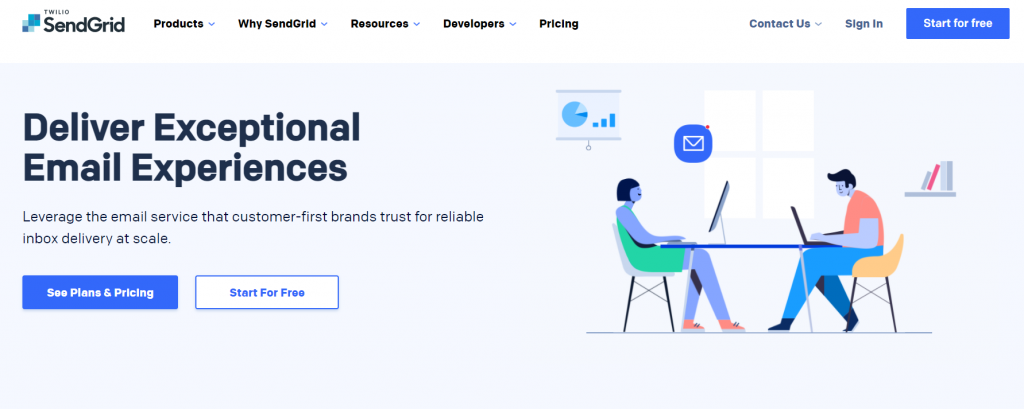
SendGrid started as an API, then had an interface and user-facing features developed and added to it later on. It still keeps its email API status with the ability to send emails both over regular SMTP or even HTTP.
It will be a tough contestant to compare with, but its counterpart today is not an ordinary tool either.
What is Mailchimp?
Mailchimp is a multi-channel marketing solution with a strong emphasis on emails. Chances are, Mailchimp was the first thing you have heard when asking peers for an email marketing service. And there is a good reason.
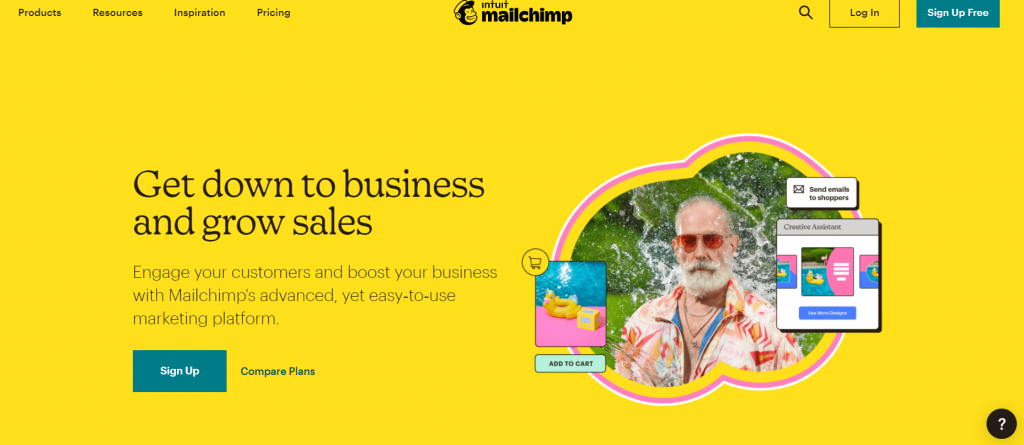
Mailchimp is very popular. They claim that around 11 million companies and individuals use them and these customers have accumulated a whopping 4 billion subscriber audience.
As a business, Mailchimp is larger than SendGrid too. Based on the acquisition cost, Mailchimp is valued at $10 billion, while SendGrid clocks in at $2 billion. Both are praised and used by many email marketing services.
So, be sure that the comparison between these two distinguished solutions will be interesting.
What is the Difference Between SendGrid and Mailchimp?
The main difference between SendGrid and Mailchimp is that Mailchimp targets the general audience with user-friendly design and easy-to-use features, while SendGrid focuses on technical excellence with exceptional deliverability and legal compliance.
Mailchimp has both the novices and power-users in mind for its features and UI. They have done their best to be easy to use, while not sacrificing features and capabilities too much.
SendGrid started as an API service, thus its technical capabilities. SendGrid has dedicated teams that work with popular email service providers like Outlook and Gmail to make sure that their emails comply both with the policies of these services and the laws. They also take care of SPF and DKIM records for you. Both are anti-spam measures used by mail servers.
But you came here for details, right? First, we will start with the advantages and disadvantages.
SendGrid: Advantages and Disadvantages
SendGrid has a prominent focus area. It is great for power users with advanced skills.
At the same time, since Sendgrid’s toolkit is created with an advanced user in mind, beginners might have trouble using it for their email marketing needs. However, let’s not rush into any decisions but look at what actual users have to say.
Advantage #1: Offers a wide range of channels
SendGrid became a part of the Twilio family after an acquisition. One of the positive sides of it was that now SendGrid users can take advantage of the wider selection of features and channels that Twilio offers. This means that other than emails, you can communicate with your audience via:
- Messaging: SMS. Whatsapp, and other chat services.
- Voice calls: receiving and making phone calls using Twilio’s voice service.
- Video calls: calling and collaborating with the real-time video service.
You can also easily integrate these channels via API reference and a set of developer tools created by SendGrid for this purpose.
Advantage #2: Offers ongoing expert consulting
There is a dedicated team at SendGrid that works solely on reviewing your inquiries, campaigns, and content for achieving better results.
With the help of expert consulting, you can:
- Setup your account and your email sending correctly in terms of configuration and technical aspects to ensure better email deliverability.
- Do the setup and configurations to scale the number of emails you can send.
- Improve the content, timing, and other points of your email strategy to get more results.
The service comes in three packages: Bronze, Silver, and Gold, with Bronze offering a monthly review and Gold including complete oversight and guidance.
Disadvantage #1: Customer support isn’t the best
Having a subpar customer support service can make anyone consider an alternative solution or option.
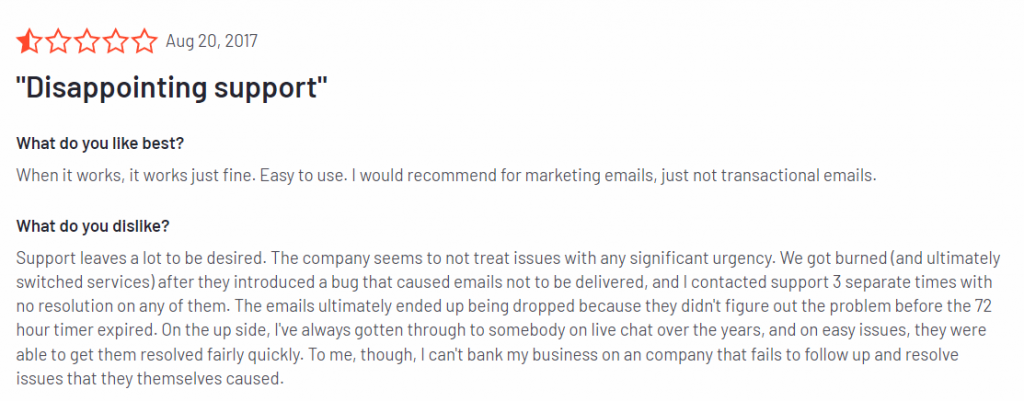
SendGrid customers have complained about its customer support many times. The problem mainly lies in timeliness. According to some reviews, whenever there is an issue that hurts your email marketing campaigns and you need the support team to resolve it quickly, you might end up opening several tickets and waiting for a resolution until it is too late or getting redirected to the knowledge base tutorials.
Disadvantage #2: Interface isn’t user-friendly
“Built by developers for developers”. This is said on the SendGrid website. Although that is great news, if you want to integrate their API into your code, it also means that the user experience is not the best one in the market.
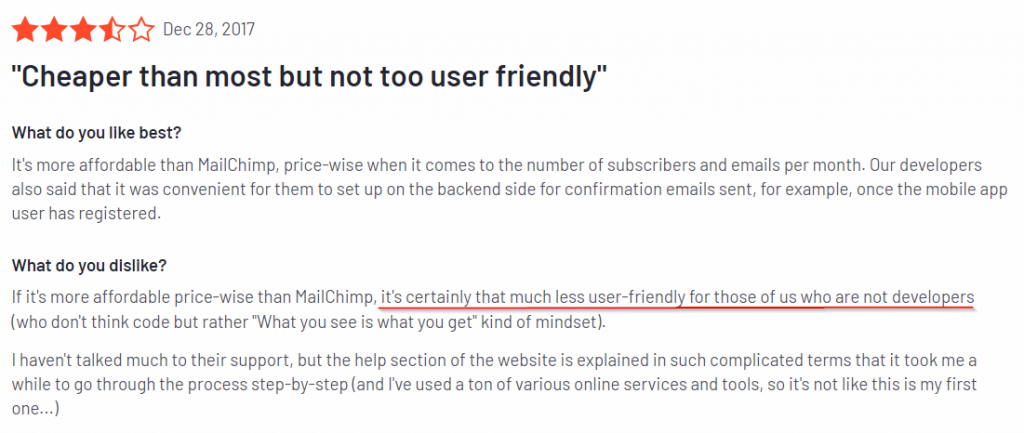
The interface is built with a confusing structure and uses lots of jargon words that a developer can understand easily, but a non-techie marketer or website owner will struggle to understand.
With the pros and cons of SendGrid behind us, let’s move on to Mailchimp.
Mailchimp: Advantages and Disadvantages
Since it’s a popular tool, users discuss and review Mailchimp a lot. There are over 4,500 reviews on G2 alone.
Let’s see what users praise about Mailchimp, and what they think doesn’t work so well.
Advantage #1: Offers many integrations
Mailchimp has built an impressive list of integrations. Over 3,000 of them, to be more precise. And this is what lots of Mailchimp users applaud and love.

It integrates with practically any type of tool that you might use. If you have an online store on Shopify with Stripe connected to it for payments, no worries, Mailchimp integrates with both.
If you are blogging with Wix and manage your blog post images on Canva, you still have Mailchimp all covered for you too.
Advantage #2: Powerful tool with many useful features
That’s true, Mailchimp is easy to use, and its interface is simple for a novice. But it does not mean that the brand has ignored the needs of power users.

As you can see from the review above, users like the fact that Mailchimp includes all the tools that they need for their day-to-day activities, from content suggestions to analyzing and improving campaigns.
Mailchimp is a multi-channel tool. Other than email, it also covers digital ads and social media. It comes with a CRM, sign-up forms, advanced segmentation, targeting users based on their past behavior, and many more features.
Disadvantage #1: No email scheduling on the free plan
Unlike many of its competitors, Mailchimp offers a free forever plan. However, it comes with a variety of limitations, one of which is email scheduling.
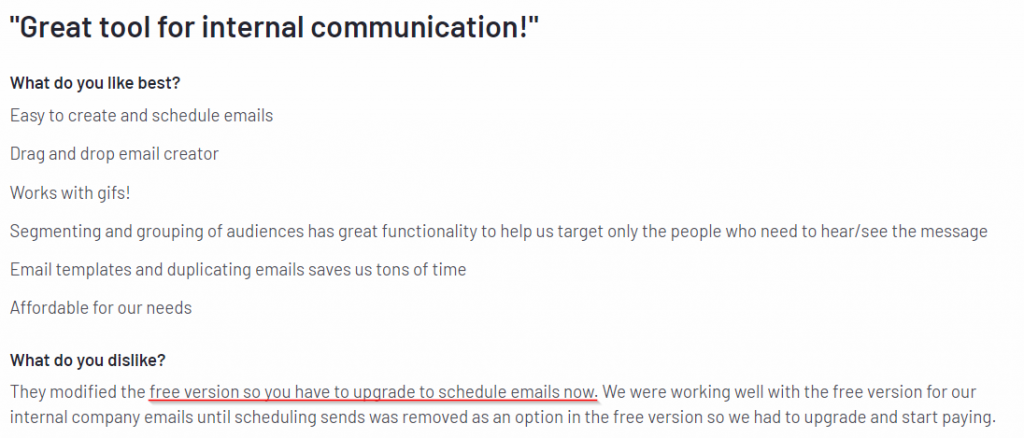
Email scheduling used to be part of the free plan, but an update in pricing plans has removed it. Mailchimp customers consider it an issue, as they have to become paid users for the sole reason of being able to send emails on a schedule.
As per user reviews, email scheduling is among the most widely used and basic features that an email marketing service should offer. And having it under a paid plan is a bummer.
Disadvantage #2: Templates are quite basic
The set of pre-made templates that Mailchimp has for its users receives both positive and negative reviews. Positive feedback praises their abundance while negative reviews say they are a bit oversimplified. There are more users complaining about the basic part, though. So, we have included the templates in the disadvantage section.

The reviewer above claims that the design and form of templates are very generic. It is hard for them to fit their company or product design and branding into the templates that come with Mailchimp.
These pros and cons of SendGrid and Mailchimp might give you the basics to make your decision. But hold on, we have more comparisons ahead.
Comparison Point #1: Features
Our two tools are packed with features.
Although slightly different from each other (considering the different things they focus on), both SendGrid and Mailchimp come with a considerable set of tools to help you cover all parts of managing your email marketing.
SendGrid
SendGrid is a multi-channel tool. It has access to the other channels from Twilio, such as messaging, voice, and video. But to make this an apples-to-apples comparison with Mailchimp, we will only talk about the features of SendGrid itself.

These features are all about email marketing. Let’s see what they have at SendGrid.
Feature #1: Email automations
SendGrid comes with an automation suite. Its email marketing workflow builder lets you create journeys for subscribers consisting of actions like storing or updating their data, sending multiple emails with delays (as in the example below), or handling transactional emails and notifications.

Some use cases for these automation workflows include:
- Warm up your audience with teaser emails before an event.
- Onboard them with a series of educational messages when signing up for your service or product.
- Follow up with people who have shown interest in your products or have abandoned them.
SendGrid’s automations also come with pre-built automation features for eCommerce stores such as shipment tracking emails, sign-up and reset password emails, promo codes, and more.
Feature #2: Email templates
SendGrid saves your time with a gallery of ready-to-use templates you can use in your campaigns.
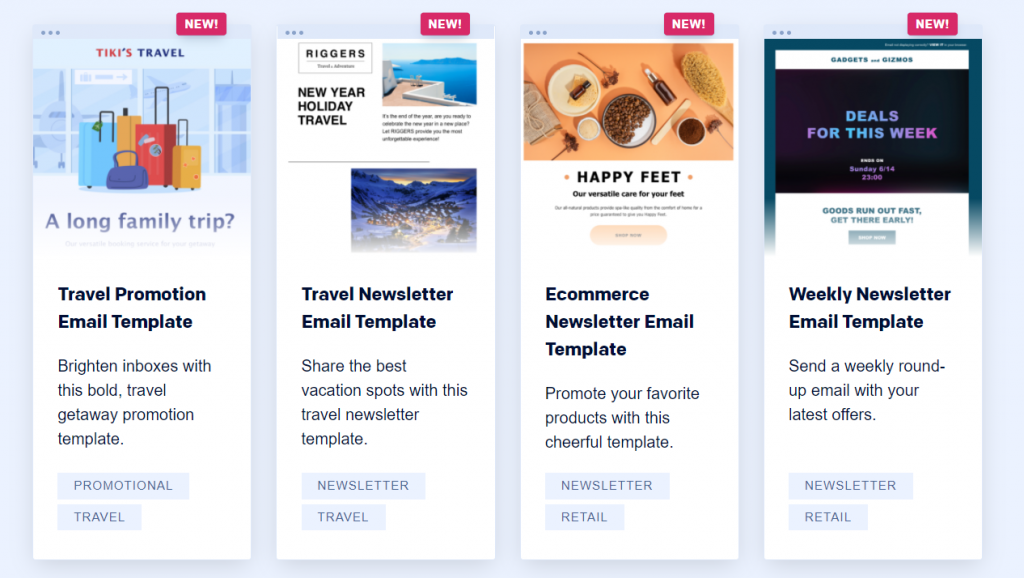
What is special about these templates is that you can customize them with your branding, logo, fonts, and other formatting. These templates come with their own CTAs and are all tested and optimized for best performance.
SendGrid also makes sure that the templates look great no matter if they open on a desktop, iOS, or Android device as all of their designs are responsive.
After selecting and customizing a template, you can save it for later use.
SendGrid templates include everything, from promotions to newsletters. By the way, check out our newsletter best practices to get the most out of your newsletter emails.
Feature #3: Email statistics
SendGrid comes with a set of analytics and statistics features designed to help users identify performance issues with their email campaigns and resolve them. You can find some of the interesting insights in the email activity feed.
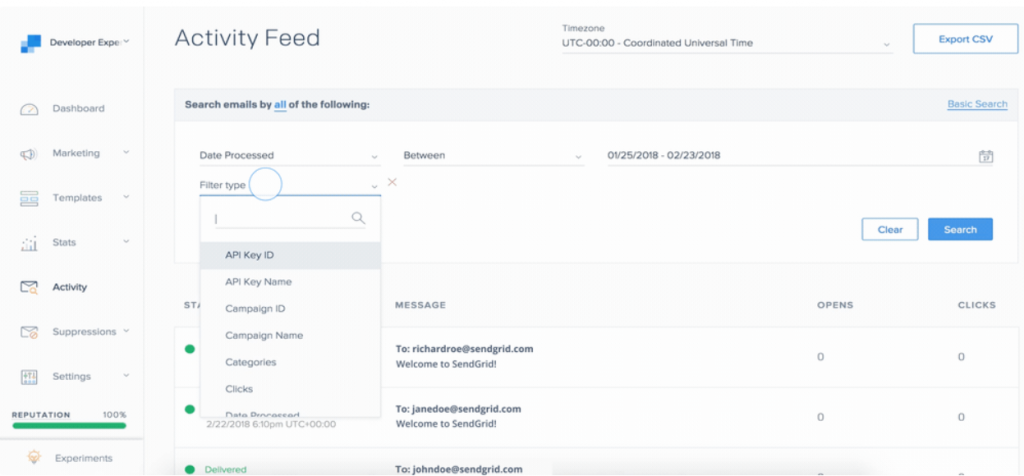
The feed shows real-time data on each campaign sent, including manual single email campaigns and automations. With the activity feed, you can track the email open rate and the click rate. There is a filter letting you see only those campaigns that match your criteria. You can also export the filtered data as a CSV file to analyze in an external tool.
Feature #4: Signup forms
Sign-up forms are a fairly common feature for email marketing tools. SendGrid has one too, and they have added their twist to sign-up forms.

Here’s what we can mention about the sign-up forms at SendGrid:
- They are embeddable with HTML.
- They come with reCAPTCHA.
- You can customize both the colors and the copy.
- There is an option to capture more info, like subscribers’ first and last names.
- They can work together with marketing automations to send emails to new subscribers.
SendGrid will even host a landing page for you with the sign-up form if you send them the link.
For an API-first product, the features of SendGrid are quite impressive. Can Mailchimp do better? Let’s see what they offer.
Mailchimp
There’s a common misconception that a product tailored for novices will lack crucial features.
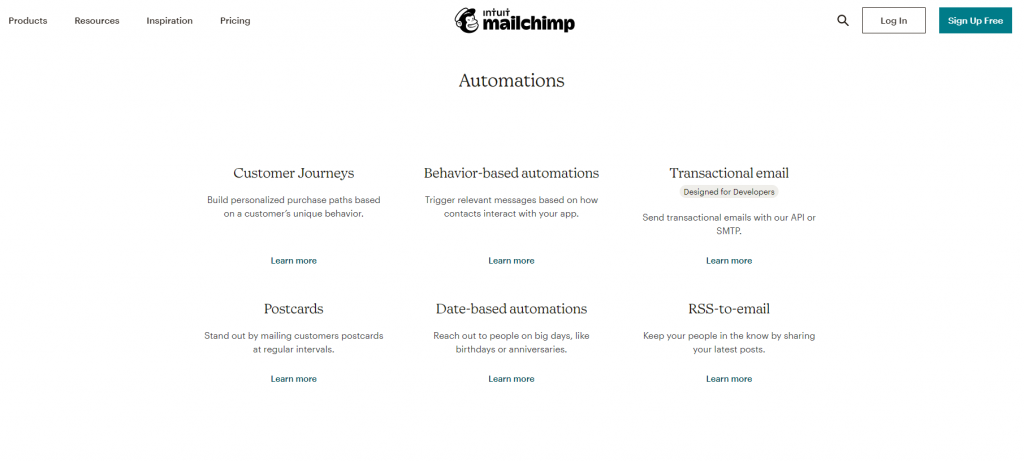
Nevertheless, Mailchimp is living proof that you can have lots of features while keeping everything simple and easy to use.
Feature #1: Email automations
Mailchimp has a customer journey builder that allows you to construct the messages your subscribers will get and tell Mailchimp which one needs to be sent to which subscriber and when.
The automations at Mailchimp come with interesting and useful features. For instance, Timewarp lets you deliver messages to recipients at a pre-set time in their time zone.

Mailchimp also allows you to automatically send emails on specific dates, like a subscriber’s birthday or several days after the user has registered on your website.
Another common type of built-in email automation is called the “Welcome Email”. Subscribers receive these messages t as soon as they sign up for emails or register on the website.
Feature #2: Email templates
Email templates save you lots of time. They are especially relevant when you do not have the proper design resource in your team. So, lucky for you, Mailchimp comes with over 100 ready templates.
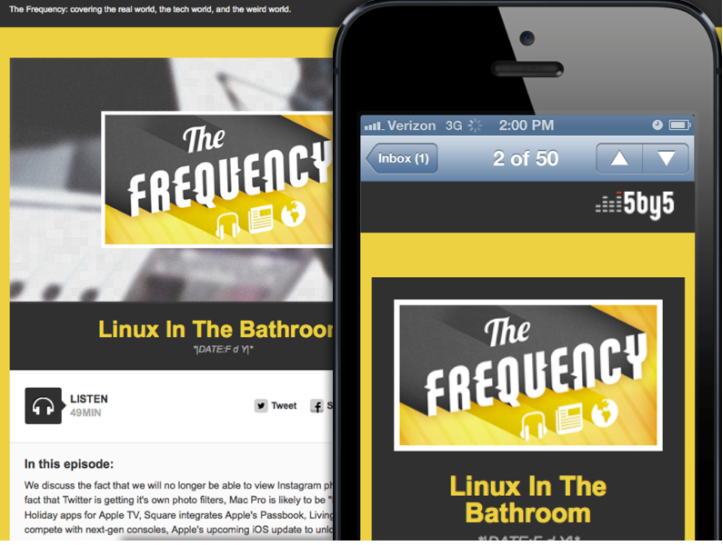
If you have already created a template elsewhere, no worries – Mailchimp will let you import its HTML version. Maybe you might consider importing some of these great email marketing examples?
Feature #3: Customer rewarding
Customer rewarding is part of the automations feature, but it is so unique we thought we should present it separately.

Mailchimp has a built-in customer loyalty automation feature. If you own an eCommerce business, you can link Mailchimp and set up a loyalty program, and specify the amount subscribers should spend to get into it. The platform will automatically send special offers and promos to those subscribers who have qualified for the program.
Feature #4: Marketing calendar
The marketing calendar is another feature that is unusual for an email marketing service. Again, it is quite interesting and useful, so we will give it some “air time” too.

The marketing calendar will show all of your campaigns, including the scheduled ones, on a monthly calendar. This feature helps you have a bird’s-eye view of your marketing activities and make changes if needed. You can also see your social and ads campaigns here too.
Both of our competitors impressed us with their capabilities. However, before considering any of them, we should see how they compare with their analytics.
Comparison Point #2: Analytics
Analytics are important for making sure that your email campaigns are making an impact. We have separated analytics and reporting from the comparison of the general features and given it a separate section for this exact reason.
There are slight differences in reporting capabilities between SendGrid and Mailchimp. But both cover the main email marketing metrics you’ll need.
SendGrid
SendGrid comes with a considerable set of reporting and analytics features. You can check the metrics of your interest on SendGrid’s real-time dashboards, export data, as well as categorize statistics with tags.

As an email service focusing on high delivery rates, SendGrid also has a separate email deliverability dashboard where you can track and manage the email delivery, bounce, and block rate of your email campaigns.
SendGrid also integrates natively with Google Analytics. The way they do it is quite simple too. SendGrid includes extra UTM tags in all call-to-action button links, so Google Analytics can catch and track visits when subscribers click on these buttons and open your website.
Mailchimp
In terms of analytics, Mailchimp does not only stand out with the number of types of KPIs you can track with it but also with the smart suggestions it can give to you based on your data.
Mailchimp comes with a smart recommendations feature that can tell you what to change in your emails to make them perform better.
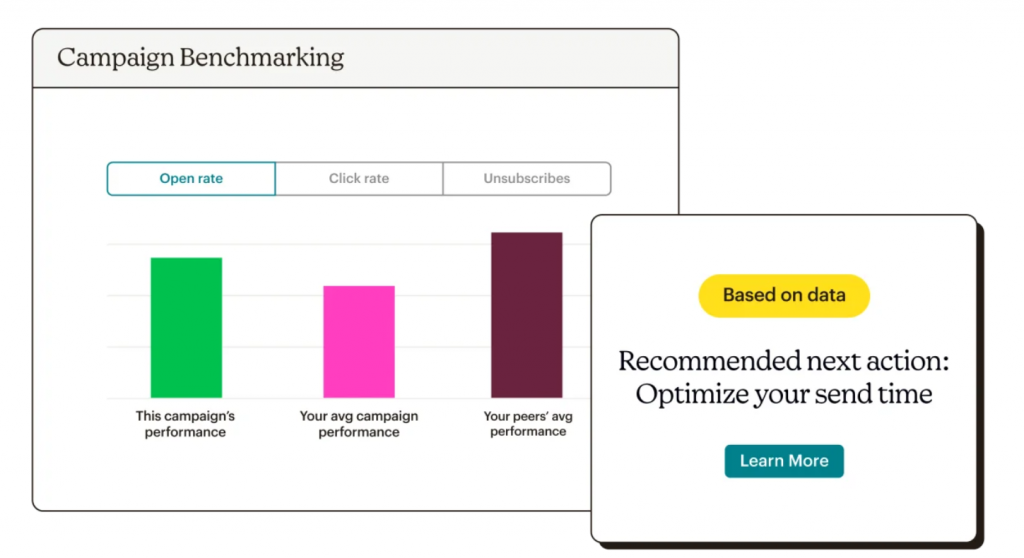
Other prominent analytics features include the click map that shows which part of your emails are the most clicked and A/B testing that lets you choose the better performing email among two variants. Additionally, a content optimization service suggests better subjects and email content.
Both Mailchimp and SendGrid stand out with their reporting capabilities. Mailchimp focuses on smart suggestions, while SendGrid excels at reporting and improving deliverability. Now let’s see how they compare with their integrations.
Comparison Point #3: Integrations
The quality and quantity of integrations have been one of the most common points in user reviews. This makes sense, as using a marketing platform with few or bad integrations would mean doing lots of work manually.
If you are wondering what 3rd party sources Mailchimp and SendGrid integrate with and if they are any good, you have reached the right part of our comparison guide.
SendGrid
SendGrid can integrate with over 100 services and tools. Their API comes with a reference and pre-made code to help make custom integrations too. We have featured several prominent integrations here for you.
Integration #1: AirTable
Airtable is an easy-to-use low-code platform for building tables and databases and managing them. SendGrid’s integration with Airtable lets you synchronize data between these two applications so you can send emails via SendGrid and manage lists in Airtable.
Integration #2: Amazon Web Services
Amazon Web Services, better known as AWS, is providing cloud hosting for web applications. When integrated with a web application hosted on AWS, SendGrid serves as its email service provider.
Integration #3: Klaviyo
Klaviyo is a multi-channel marketing tool specializing in SMS. You can use it to promote your campaign through SMS along with the emails in SendGrid.
As you can see, SendGrid’s integrations are quite impressive. But let’s check Mailchimp’s list to see which one is better for you.
Mailchimp
Mailchimp integrates with over 3,000 services (mostly thanks to its integration with Zapier). It does have an API with reference too for custom code implementations. Here is Mailchimp’s set of featured integrations.
Integration #1: Shopify
Shopify is an eCommerce website builder. Mailchimp’s integration with Shopify includes syncing Shopify data with Mailchimp’s CRM, getting data about shoppers to send them personalized emails, and using Mailchimp’s Customer Rewarding feature for Shopify users.
Integration #2: Stripe
Stripe is a payment processing platform. When Mailchimp is integrated with it, you can include payments functionality on Mailchimp landing pages.
Integration #3: QuickBooks
QuickBooks is an accounting service for small businesses. With Mailchimp integration, you can import customer information from QuickBooks and use it for automations and targeting.
To sum up, Mailchimp and SendGrid have lots of integration options and extra features coming with them. But hold on, there is also the pricing comparison left for you to have a full view.
Comparison Point #4: Pricing
We have reached our final comparison criterion. Many users often avoid the services that lack a free trial or have very few features in their starter plans.
Fortunately, both SendGrid and Mailchimp have free forever plans. Let’s see what else they have in terms of their paid subscriptions.
SendGrid
SendGrid’s price can change based on the plan, the number of contacts, or the number of emails sent per month.
It offers a Free plan which stands out with a good set of features, as there are only a few extra solutions you can get if you switch to the Advanced plan. The Free plan is limited to 2,000 subscribers and 6,000 emails per month.
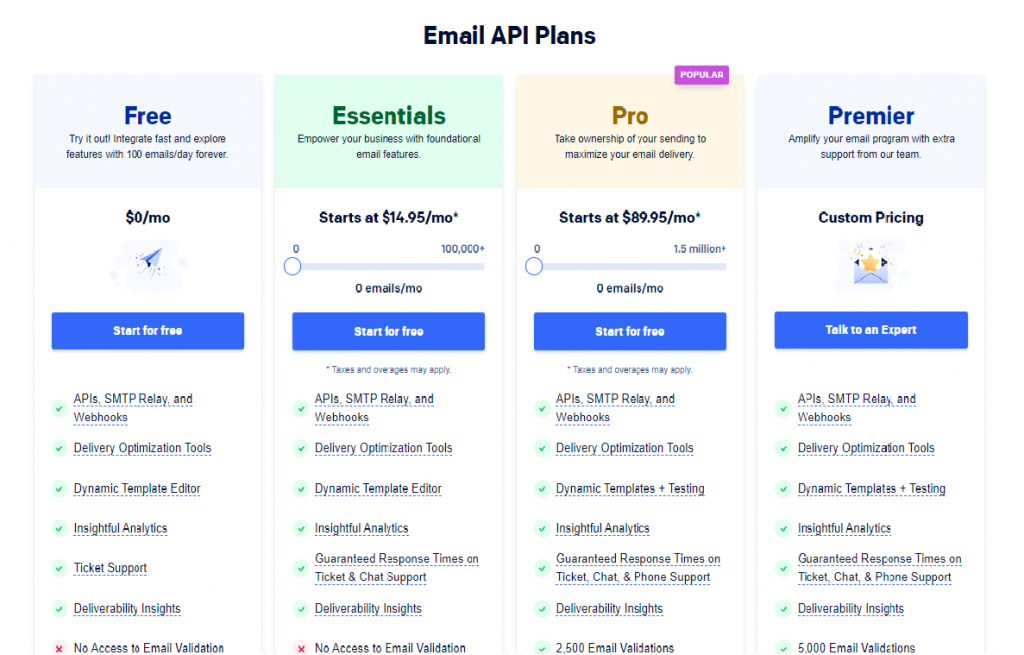
Basic and Advanced plans add sub-user management, more customer support channels like phone support, chat support, and dedicated IP. In terms of prices, they range from $15-$200 for the Basic plan and $60-$900 for the Advanced plan.
Mailchimp
Unlike SendGrid, Mailchimp’s prices do not depend on the number of sent emails. They differ based on plans and the number of contacts.
Mailchimp has a Free plan too. It is limited to 2,000 contacts and 12,000 emails per month.
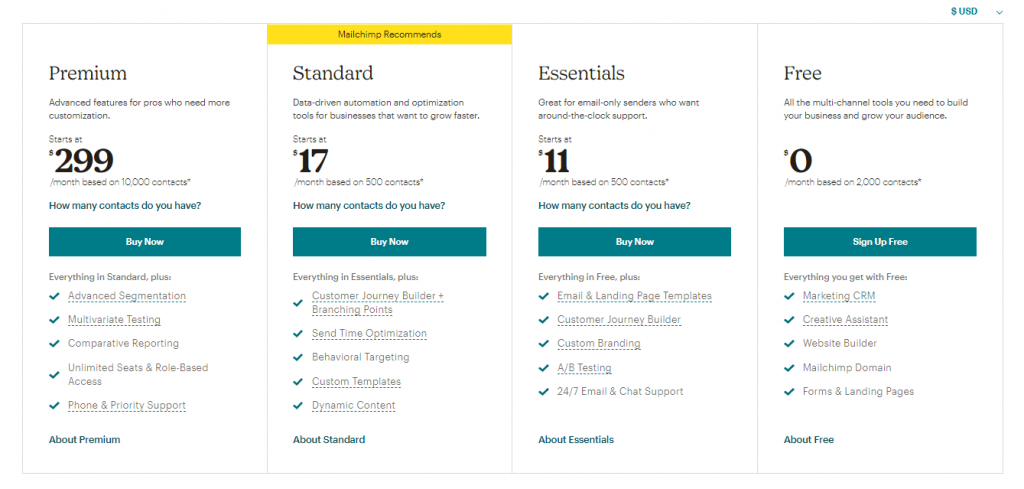
There is also the Essentials plan costing $11-$299, the Standard plan for $17-$605, and the Premium plan for $299-$1,300.
We hope that the pricing comparison, added to the other aspects that we discussed in this comparison guide, helped you complete your decision.
Now Over to You
Both SendGrid and Mailchimp do a great job for the market they are targeting. If you need high stability, advanced technical integrations, and good deliverability, then SendGrid is your option. But if ease-of-use and abundance of features are more important to you, then you will like using Mailchimp instead.
Whatever you do, or whichever online business model you follow, doing email marketing is a must. And these two tools are just great for you!
Want to learn more about digital marketing?
There are lots of interesting guides and articles on our blog, go check them out!

Sona Kalantaryan is a senior digital marketer with a creative past. Big fan of high cinema and well-optimized landing pages. She authors guides by sharing the best practices and does it the right way!
